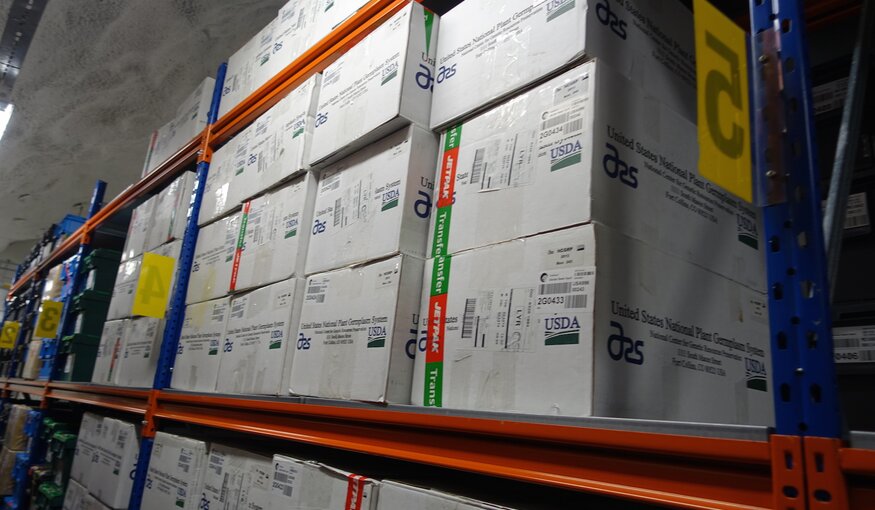Thousands of Years of Global Agricultural History Preserved for Future Generations

International efforts to guarantee the future of world food supplies will see thousands of seeds from almost every country in the world deposited safely in a vault deep in a mountain in the Arctic this week. The seeds will be preserved for generations in the Svalbard Global Seed Vault.
The shipments have been dispatched from all over the world – from the heart of the Rocky Mountains to Benin in West Africa, and will be added to the 839,000 samples already in the vault. They include accessions from the United States Department of Agriculture (USDA), AfricaRice, an international pan-African agricultural research organisation, and the Nordic Genetic Resource Centre (NordGen), each working in partnership with the Global Crop Diversity Trust. The deposit will be attended by German Parliamentary State Secretary Peter Bleser, who will inspect the deposit that Germany made in October last year.
The Crop Trust is the only international organisation devoted solely to ensuring the conservation and availability of crop diversity in genebanks worldwide. It funds the operations of the Seed Vault together with the Government of Norway and NordGen, and is raising an USD 850 million endowment to provide permanent funding for the key international seed collections that are critical to our food supply.
The Vault stores duplicates of seed samples stored in the world’s genebanks, and a wide variety of crops will be deposited for safe storage on this occasion. The deposit from the United States alone contains seeds collected from around 150 different countries. Many of these are wild relatives of domestically cultivated crops, and typically more hardy and resistant to adverse conditions; including 27 species of sunflowers, wild carrots and two varieties of pumpkins developed by the Mandan and Omaha Native American tribes.The shipment also contains 14 species of wild tomatoes including five populations of Solanum cheesmaniae, which hail from the Galapagos Islands.
Every seed has its own story, part of the nearly 12,000 years of agricultural heritage that are preserved in the Vault. Oryza glaberrima, a rice species first domesticated in the inland delta of the River Niger over 3,500 years ago is being sent from Benin, whilst the Scandinavian deposit includes everything from ancient medicinal plants found growing in old ruins to Camelina sativa, a member of the mustard family with high protein and oil content. It requires little water and can be refined into biofuel or animal feed.
Depositing these seeds in Svalbard secures their rich genetic reservoir. Plant breeders and scientists need access to the widest possible genetic diversity, to breed the new crops required now and in the future to feed a growing global population in a world facing numerous challenges. These challenges range from climate change, to new pests and diseases, increasing pressures on agricultural land and more expensive inputs.
The preservation of native species is also vital for repopulation efforts. In the United States, for example, there is a growing focus on ensuring there are sufficient quantities and variety of native seeds on hand for restoration efforts following wildfires, floods and other natural disasters that could otherwise cause irreparable damage to natural ecosystems.
The Crop Trust‘s collaboration with seed banks around the world ensures that current and future generations will continue to have access to the genetic resources required to feed themselves.
Peter Bleser, Parliamentary State Secretary at the German Ministry of Food and Agriculture, who visited the Vault during the deposit said:
The work of the Svalbard Global Seed Vault and the Crop Trust to conserve crop diversity here in the arctic cold and across the world is essential for the success of agriculture in the future.
“I am proud to say that the Federal Republic of Germany has sent more than 40,000 samples of crops to the Seed Vault and continues to support the work of the Global Crop Diversity Trust.
Dr Stephanie Greene, Seed Curator at the United States Department of Agriculture, said:
Preserving crop diversity – the wonderful plant genetic resources that live and grow in our own backyard – is an area where we can really make a difference.
Working in partnership with the Crop Trust, the USDA is able to have a ‘back-up for our back-up’. We already have 69,000 accessions safely stored in the Seed Vault at Svalbard. The latest shipment adds nearly 20,000 more, from around 650 species, including a large proportion of varieties unique to the US. Almost 20% of the entire US collection is now stored at Svalbard. This partnership approach ensures these resources remain available for future generations.
Dr Marie-Noelle Ndjiondjop, Head of Genetic Resources Unit and Theme Leader at AfricaRice for “Harnessing genetic diversity to chart new productivity, quality, and health horizons” of the CGIAR Research Program on Rice known as the Global Rice Science Partnership, said:
We see the work of the Global Crop Diversity Trust is particularly vital because Africa is bearing the brunt of all of the global challenges that threaten food security, such as political instability, climate change and population increase. We must not lose the ability to develop the crops that will help us to meet and overcome these challenges.
Categories: For The Press, Press Releases, Svalbard Global Seed Vault
